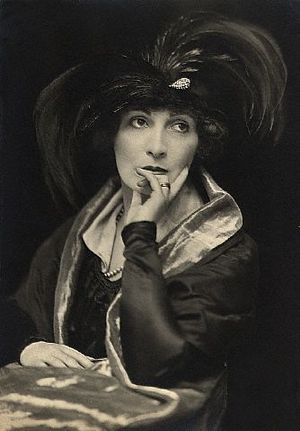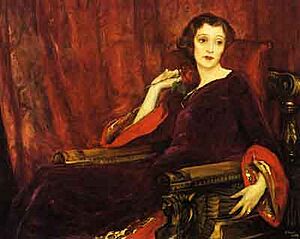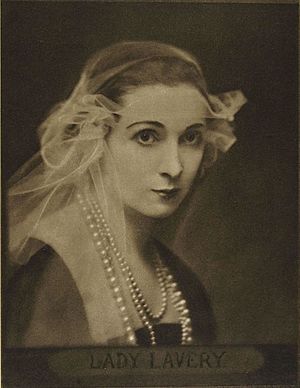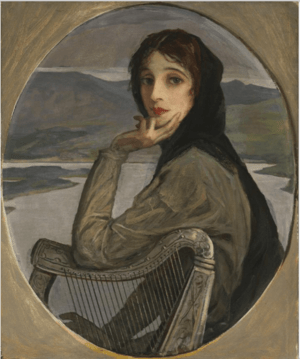Hazel Lavery facts for kids
Quick facts for kids
Hazel
Lady Lavery
|
|
|---|---|
 |
|
| Born |
Hazel Martyn
March 14, 1880 |
| Died | January 1, 1935 (aged 54) London, England
|
| Nationality | American |
| Spouse(s) | |
Hazel Lavery (born Hazel Martyn, 1880–1935) was a talented painter. She was also the second wife of a famous portrait artist named Sir John Lavery. You might have seen her face on Irish banknotes, where it appeared for many years!
Contents
Hazel Lavery's Early Life
Hazel Martyn was born in Chicago, USA, on March 14, 1880. Her father, Edward Jenner Martyn, was a very successful businessman. People at the time even called young Hazel "The Most Beautiful Girl in the Midwest".
Hazel had a younger sister named Dorothy. Sadly, Dorothy passed away in 1911 when she was only 23 years old. This sad event encouraged Hazel to leave America and travel.
Hazel Lavery's Personal Life
In 1903, Hazel married Edward Livingston Trudeau Jr. His father was a doctor who helped improve treatments for a serious lung illness called tuberculosis. Sadly, Edward Jr. passed away just five months after they were married. They had one daughter together, named Alice, who was born in 1904.
While she was still married to Edward Jr., Hazel met Sir John Lavery. He was a painter from Belfast. After her husband died, Hazel and John Lavery married in 1909. Hazel then became the person John painted most often.
During World War I, John Lavery became an official artist for the British government. In 1918, he was given a special honor called a knighthood. This meant he became "Sir John Lavery," and Hazel became "Lady Lavery."
The Laverys had a beautiful home in South Kensington, London. They let the Irish group, led by Michael Collins, use their house. This was during important talks for the Anglo-Irish Treaty in 1921.
Lady Lavery passed away in London in 1935. Her funeral was held at a church called the Brompton Oratory. She was buried with her husband in Putney Vale Cemetery. In Ireland, a special service was held for her because the government asked for it.
Hazel Lavery on Irish Banknotes
After the Anglo-Irish Treaty was signed, the new Irish government wanted a special image for their new banknotes. They asked Sir John Lavery to create a picture of a woman who would represent Ireland. This idea of a woman representing Ireland comes from old Irish mythology. Famous writers like James Clarence Mangan and William Butler Yeats also used this idea in their works.
Sir John Lavery painted a picture of Lady Lavery to be this symbol of Ireland. This painting was used on banknotes of Ireland from 1928 all the way until the 1970s. Later, her image appeared as a special hidden picture (called a watermark) on other Irish banknotes. These notes were used until Ireland started using the euro currency in 2002.
Many Portraits of Lady Lavery

Sir John Lavery painted Lady Lavery more than 400 times! Many of his paintings of her had similar names, often starting with "Hazel in..." One famous painting is called "The Red Rose" (1923).
Lady Lavery's Famous Friends

Lady Lavery knew many important people of her time. She wrote letters to famous figures like George Bernard Shaw and William Butler Yeats. These letters were made public after she passed away. They show a lot about her personality and how her friends saw her. Her letters even mention a visit to Ireland by the British Royal family. In letters from Winston Churchill, he shared his worries about the creation of Northern Ireland.
Images for kids




